The wisest way to look at world religions is to focus on what connects rather than what divides us. The ancient mystics deliberately hid meanings that have a profound, uplifting and unifying message within specific practices. Tantra teacher Foca Yariv had this realisation in his early life growing up in the Holy City of Jerusalem, as he searched for a common truth among the noise and hubbub of Judaism, Christianity and Islam. Foca has drawn common threads from his knowledge of these spiritual traditions, and created a workshop that explores the unifying force between them, and ways in which this force can reinvigorate the yogi on the Tantric path. Get a sneak preview of this workshop, to be held on 12th May in London by listening to this podcast. Foca begins by telling student Vivienne Rush about the challenge of living at the crossroads of three world religions.
Category: Inspiration
In this podcast episode, Tantra and Yoga teacher Uriel Yariv shares with us about how to become more emotionally wise, and how to consciously heal emotions in a healthy and wholesome way, as well as about his own experience with healing emotions.
Listen to learn more about what emotions are, about what we think we ‘should’ or ‘shouldn’t’ do with emotions, and about how through awareness of emotions, a process of alchemy starts to take place.
To find out more about emotional healing through the ancient spiritual practices of Yoga, Tantra, Mystical Christianity and Tibetan Buddhism, in combination with modern psychology, we had our ‘Wisdom of Emotions’ workshop on 22nd-23rd April 2023.
To see what events we have coming up soon, see our events listing!
I had the opportunity to attend this particular workshop at Tara Yoga Centre in London. I had heard of lucid dreaming before and I experienced it personally. Many nights I was aware that I was dreaming and I would wake up just after having realised that I was doing so. I did not know that this state could be trained so that one could enter it whenever they wished. Having had many vivid dreams where I was aware I was dreaming all my life – later I would find out they were called lucid dreams, when the opportunity arose to attend such a workshop, I immediately took it.
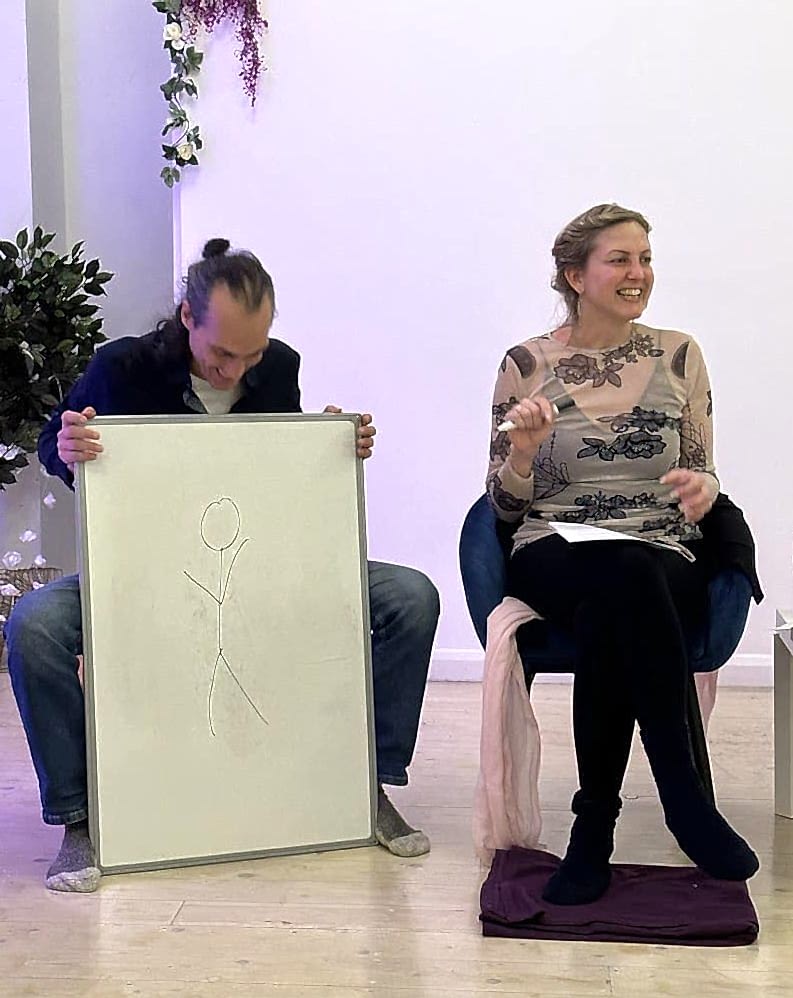
Our teachers were Maria and Morgan, both experienced in the field. Maria had been experiencing lucid dreaming since she was a small child, and Morgan said that every single one of us on the planet dreams, reassured me that I was in good hands. What followed was a very interesting history of how lucid dreaming has been represented throughout history. I found out that numerous ancient cultures from the Chinese to the Hindus recognised this special state, and many aspired to reach it when sleeping for numerous benefits such as clairvoyance, therapy and improving spiritual practice.
We were taught about the sleep cycle, deep sleep, REM sleep, hypnogogic states and when lucid dreaming is more likely to occur.
We learned that in the modern day in the West, lucid dreaming was first researched in 1975 and expanded upon in 1980 and most importantly in 2010. This was when modern brain scans proved lucid dreaming scientifically, and numerous experiments showed that people were conscious even when they were not awake.
Morgan and Maria taught us the 3 main ways to lucid dream:
- DILD: Dream Induced Lucid Dream
- WILD: Waking Induced Lucid Dream
- MILD: Mnemonic Induced Lucid Dream
The day also included numerous practical aspects of lucid dreaming. We did an experiment on awareness and concentrating on the five senses, as well as two lucid dream experiments based on the WILD method, for around ten minutes and thirty minutes. The second experiment gave the best results for me, in that I could actually feel myself falling asleep and start to dream, but I was also completely conscious of this happening, and could bring myself back into a waking state. I found it was very new to me and completely amazing!
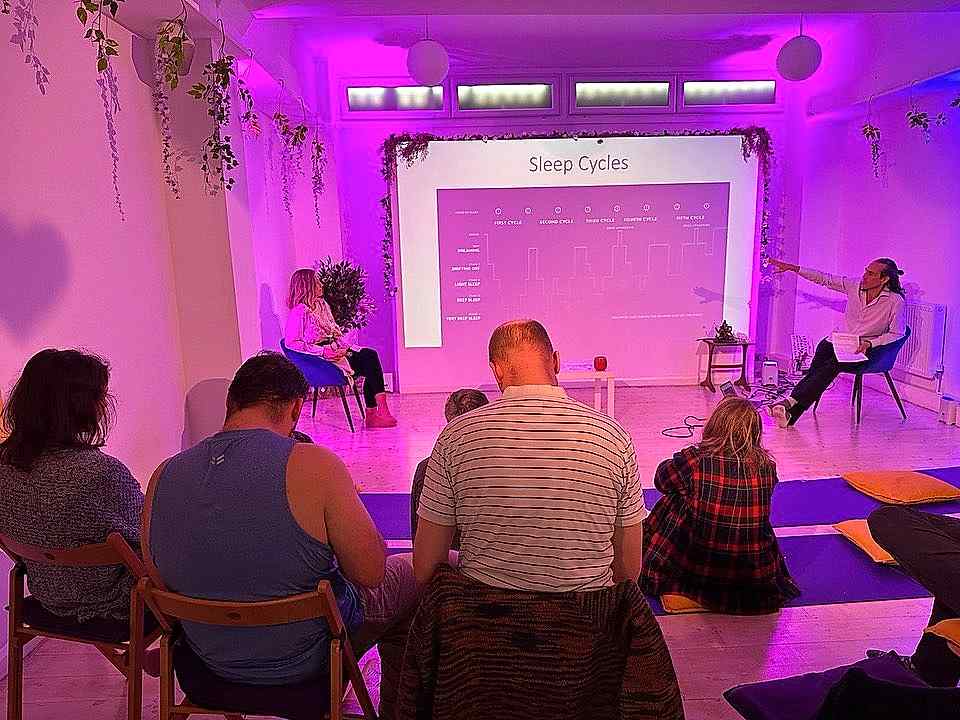
I also learned ways to document and keep track of dreams, from keeping a journal by the bed, to specialised phone apps and sleep friendly screen lights, to alarms that can wake you at night periodically so that you can document your dreams.
Over the weekend I met people who had very wonderful testimonies on their lucid dream states, and we all shared from our experiences. I would definitely do such a workshop in the future! It taught me many useful things that will enrich my spiritual practice, help me overcome fears and allow me to have wonderful all night adventures in my sleep.
Happy lucid dreaming everyone!
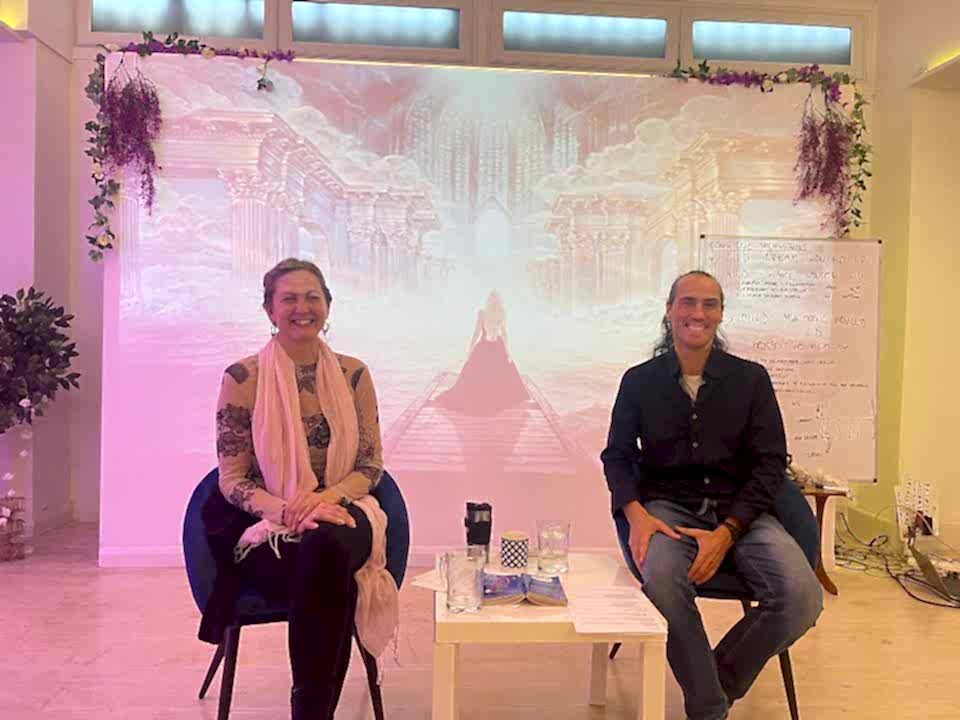
by Cosmin Maris
When we are ill, we have one wish – to be whole again, to be healed. There is often a sense that we should not be ill in the first place and that as soon as the symptoms appear we need to get rid of them, by all possible means.
But what if we approached our symptoms with a degree of positivity, as signals and messages from deep within us that will help us not only to heal but also to progress along our spiritual path?
Deciphering those messages is an essential starting point, as teachers Kate Wallwork and Nikos Frangi told student Vivienne Rush in this podcast, outlining some of the tools and techniques in Tantra and Yoga that can facilitate spiritual healing.
Attendees to the workshop when you listen to the podcast, please note any questions you would like to take along to the Spiritual Healing workshop in London on Saturday 25th March.
What if we could use the time we normally spend sleeping, to learn, to grow, to solve problems and connect with our deep authentic selves? What if we stopped being frightened about life after death and became practised in inhabiting the astral plane instead?
As Tara teacher Morgan Arundel explains to student Vivienne Rush, through lucid dreaming we can open up an exciting new world of many dimensions and possibilities.
And if you want to go even deeper, Tantra and Yoga teacher, Morgan will be running an entire weekend workshop on Lucid Dreaming in our Oxford Centre on the 27 – 28th April 2024.
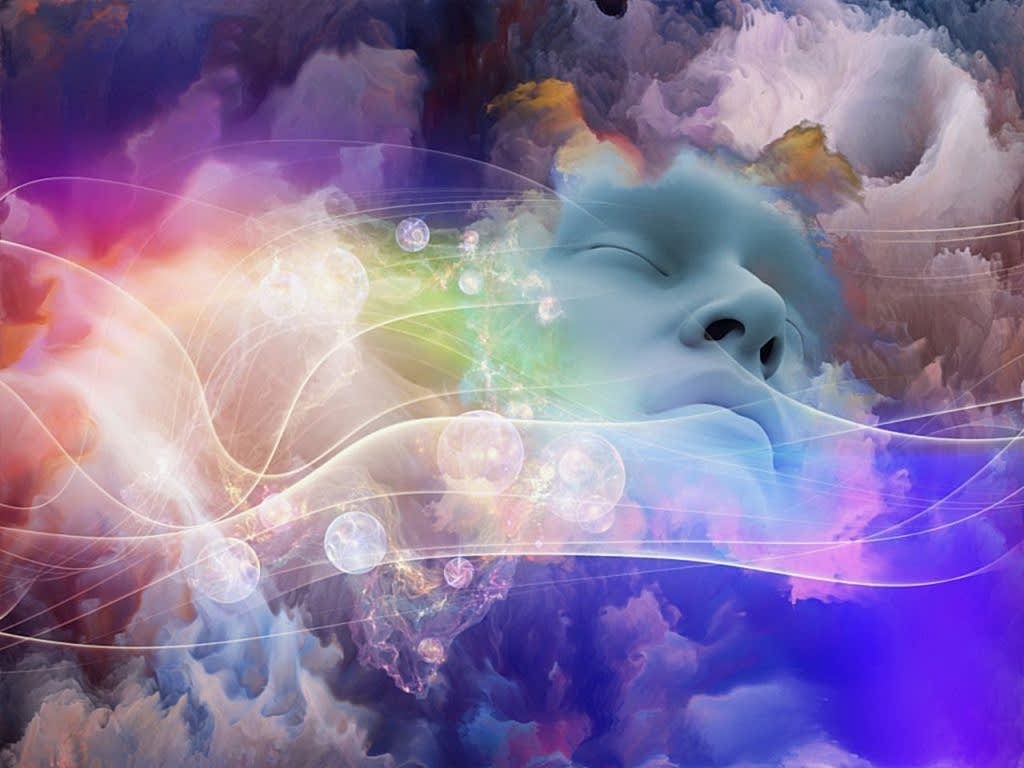
“All that we see or seem is but a dream within a dream.”
– Edgar Allan Poe
Angels are Here!
Angels are here and yet…we forget to connect with them in our everyday lives.
Ever modest and respectful of our free will, they will never intervene unless they are called. As human beings we feel close to Angels, resonating with their light and their loving presence, feeling peace and reassurance. But we forget to ask for their support.
An angel can remind us how to be our magnificent selves. An angel can protect us from sadness, and guide us when we go astray, shining a light on our paths home. An angel can personify the qualities we wish to manifest in our lives.
We have just to ask!
We warmly invite you to Angels and Archangels week, which we hold every year at the end of October – beginning of November. During this angelic celebration we will bring the reality of the angels and archangels of light alive in our hearts through meditation, artistic expression, workshops and other activities. All activities related to the week are completely free, with donations welcome.
Find out more about the next Angels and Archangels Week!
“Every visible thing in this world is put in the charge of an angel” ~ St Augustine
“To love for the sake of being loved is human, but to love for the sake of loving is angelic” ~ Alphonse Marie de Lamartine
Angels are beings of light, and they are described in many different religions and spiritual traditions as well as by ordinary people. They are described as being the guardians of man, messengers of God, facilitators of the Will of God, and supporters and protectors of the manifestation, of the entire world with their enormous power. Angels are beings of Truth, Purity, Love, Harmony, Perfection and Wisdom. They are beings of a higher vibration that inspire, protect and guide. They are the connection, or the bridge between Heaven and Earth.
The word angel comes from the Greek, άγγελος aggelos, meaning the one that brings the godly message to the human beings.
Emanuel Swedenborg, an 18th century Swedish scientist, mystic and clairvoyant had extensive experiences with angels. He mentioned that there is an unaccountably vast number of angels, with their own cities, houses, clothes, language, qualities and attributes.
Different faiths, mythologies, spiritual traditions, philosophies and cultures refer to angels, and they are also described throughout history, from pre-dynastic or ancient Egypt to modern times. In the Hindu and Buddhist traditions, angels are called devas, or godly messengers. In the Islamic tradition angels are called Malaikah, and in Judaism they are known as Malachim.
Common to all traditions is that angels are the godly messengers that bring the word of God to human beings, and thus they connect us to the Divine.

In the Christian tradition, The Celestial Hierarchies is ascribed to Dionysius the Areopagite, who described the angelic hierarchies, also known as the spheres and choirs.
- The first hierarchy is the closest to God and directly receives the light from the Source. It consists of the Seraphim, the angels of pure love, the Cherubim, the angels of wisdom, and the Thrones, the great supporters of the entire cosmos.
- The second hierarchy protects the divine purpose. It comprises the Dominions, the celestial prefects and defenders against evil, the Virtues, the healers that make miracles happen, and the Powers, the Lords of Karma and the angels of birth and death, associated with the stars.
- The third hierarchy cares for all created beings. It consists of the Principalities, who protect cities, nations, large corporations and any large structure of people, the Archangels, who lead bands of angels and oversee large projects with the light (the closest Archangels to earth are Michael, Gabriel, Raphael, Uriel), and the Angels of Light.
The closest angels to human beings are Guardian Angels, who are with us all the time in their role as the gatekeepers of our souls. Our Guardian Angel is with us from the moment of our birth, and always watches over us. The Guardian Angel can call other angels to come into our life to help us, and so asking for the help of your Guardian Angel can bring help from an uncountable number of angels. Our Guardian Angel is always by our side, and ready to help us in any way, taking part in every little detail of our lives. Even though the only task of our Guardian Angel is to help and guide us, he or she cannot if we do not allow this help.
Common to all traditions is that angels are the godly messengers that bring the word of God to human beings, and thus they connect us to the Divine.
Angels cannot interfere in our lives uninvited, as they have an endless respect for our free will. In this respect, it is good to remember the message of the words of Jesus: “So I say to you: Ask and it will be given to you; seek and you will find; knock and the door will be opened to you. For everyone who asks receives; he who seeks finds; and to him who knocks, the door will be opened”. ~ Luke 11:9-10 NIV
Angels are here to assist us and influence us in the most positive way, but always respecting our individual freedom. We only need to remember to ask for their assistance, guidance and protection.
In Angels in my Hair, Lorna Byrne says, “God is pouring these beautiful angels out on this world for us, and yet many of us ignore them”. She says that angels whisper advice in people’s ears but we often think it is a silly thought and we disregard what we are asked to do. To hear this whisper clearly, and to dare to follow it, we need to open our minds to the existence of angels and learn to listen to their voices in our hearts – the voices which are actually the voice of God.

In everyday life when we say someone is an angel or like an angel we speak about purity, inner beauty, or we describe a kind and loving person. One who manifests goodness, purity and selflessness. One that through his or her service or simply just by his or her presence makes a difference in the lives of others, and who makes life better. This is a person who, knowingly or not, is in contact with the world of angels, or as we say in yoga, a person who is in resonance with the sphere of force of the angels.
Amplifying a connection with angels can be done through dreams, meditation, prayer, or simply by invoking them. Opening our heart and becoming more kind, giving and loving will enable us to enter in resonance with angels, as they are an expression of the pure love of God. The more we nourish a connection with angels, the more sensitive we will become to their presence and the more we will hear their voices speaking the language of godly love in our hearts.
We warmly invite you to Angels and Archangels week, which we hold every year at the end of October – beginning of November. During this angelic celebration we will bring the reality of the angels and archangels of light alive in our hearts through meditation, artistic expression, workshops and other activities. All activities related to the week are completely free, with donations welcome.
Sexual practices are probably what has made Tantra most known in the West. However, in reality, Tantric practices of intimacy are erotic rather than sexual.
Eroticism is the experience of our sensual self, without the component of the instinctual behaviour that drives us to procreate – which is what defines a sexual act. If we do not engage in sex for the purpose of procreation, it is done to experience pleasure and to express feelings for the other. Sex is driven by instincts, so while it is pleasurable, it is a superficial pleasure and not fulfilling beyond that brief moment. What we are really longing for is the erotic experience.
To obtain deeply fulfilling pleasure and profound connection, we need to discover eros.
Eros is an expression of physical love and elevated passion, where the other is not an object for satisfaction, but a beloved being with whom we merge – and at the same time, eros is a revelation of our own innermost being.
At first glance, sex and eros might appear to be the same, and we might think that eros is just a nicer term for sex. But, like sugar and honey, both taste sweet but have very different effects on health and well-being, just as sex and eros affect us in radically different ways.
Sexual energy is overpowering, bringing a loss of control, and it often leads to over-indulgence or obsession, or to forced avoidance, emotional rollercoasters, painful attachments, and experiences that either fall short of expectations or that bring outright regret.
In contrast, erotic energy brings an out of this world feeling of pleasure that is deeply satisfying and leaves a feeling of profound happiness and fulfilment – the experience that most are longing for when approaching intimacy.
The shame and inhibition many experience around their sexuality, aside from any past experience of abuse, is related to the instinctual nature of sex, and the loss of control that comes with it. In the grip of instinctual sexual energy, we trust neither ourselves nor the other. When the intimate experience is one of pure eros, there is no shame or inhibition, and the possibility for profound intimacy and oceanic pleasure is born. This then makes the erotic interaction a deeply fulfilling, healing and awakening practice that, rather than being controlled by it, allows us to harness the immense power of our creative potential.

When the intimate experience is one of pure eros, there is no shame or inhibition, and the possibility for profound intimacy and oceanic pleasure is born.
Amorous Erotic Continence
The creative potential is an immense force that gives the power to create new life, but it can also be used to nourish life in other ways; to awaken latent potential, to support health, regeneration and longevity, to sustain and expand spiritual experiences of higher states of consciousness, and to create new ideas, inspirations, inventions and genius-like solutions.
We tend to take the gift of this potential for granted, until it runs out. Tantra teaches methods for harnessing this power, and how to use it consciously, not only for greater fulfilment in intimate experiences, but for an overall upgrade of our life and being.
This practice is called amorous erotic continence. It involves learning to increase and expand pleasure, to experience multiple orgasms without wasting any of the creative potential through ejaculation for men, and through explosive orgasms for women. By separating the orgasm from the ejaculation, men can learn to be multi-orgasmic, and women will be able to fully embrace their natural ability to experience multiple orgasms, as well as to intensify and deepen their experience of orgasm, resulting in a profound fulfilment and revealing a new dimension of eroticism.
Through the practice of amorous erotic continence, we become able to experience a much greater intensity of pleasure. Not only is it possible to experience more than one orgasm, but the intensity of the experience is greatly increased. The ejaculation or explosive orgasm occurs when the threshold of the intensity of pleasure that can be held in the awareness is reached. With practice, this threshold can be raised and the level of pleasure that can be experienced by both lovers becomes greater and greater, leading to truly overwhelming and expansive states of orgasm beyond anything that has been lived before.
Tantra teaches methods for harnessing this erotic power, and how to use it consciously, not only for greater fulfilment in intimate experiences, but for an overall upgrade of our life and being.

Furthermore, the two lovers can become able to prolong the experience of the orgasm, which then becomes a genuine gate to spiritual experiences, that can be passed through into higher parts of the being, and into the creation itself.
Through the process of inner alchemy, the lovers can also transform their sexual potential, that is in the form of sexual fluids, into energy. The resulting energy can then be sublimated into more refined forms of energy such as affectionate, emotional, mental, and spiritual energies.
The lovers remain completely capable of procreation, and ejaculation is only used when the couple want to conceive. In any other situation, ejaculation is considered an unnecessary loss of energy that over time only has negative depleting effects, and leads to a diminishing of erotic interest in the erotic partner.
Orgasm with ejaculation is known to deplete the vital resources of the body. High-performance athletes, for example, are advised to refrain from ejaculating before important competitions – as are those preparing for high intellectual performance. On learning to separate orgasm from ejaculation, abstinence is no longer needed. Instead of depleting energy, intimacy can charge the battery of the being, and help in preparing for life and its most demanding situations. Our intimate life becomes not only a source of immense indescribable pleasure, but it also becomes an engine for the transformation for the better of our entire being and existence.
Our intimate life becomes not only a source of immense indescribable pleasure, but it also becomes an engine for the transformation for the better of our entire being and existence.
Effects of Erotic Amorous Continence
Effects observed by those who have successfully practised amorous erotic continence for longer periods of time:
- The intimate experience becomes more fulfilling and complete
- Prolonged orgasms without a loss of energy cancel the effects of negative emotions
- Stress and anxiety are diminished and eventually replaced by a state of inner peace and relaxation
- A deepening of love and increased happiness in relationships
- Increased erotic appetite amplifies or restores the attraction between lovers.
- Works as a powerful aphrodisiac
- Increased creativity and intelligence
- Improved quality of sleep and a reduced need for sleep
- Alleviates and even cures ailments or physiological disorders
- The body becomes more harmonious
- Increased sensuality and wellbeing
- Charisma and magnetism is awakened or amplified
- Increased self-confidence and optimism
- Increased ability to be empathic
- Brings more energy and even a surplus to fulfil life goals and aspirations
- Natural contraceptive with no negative side effects
These are just some of the many miraculous effects that can be observed from the practice of amorous erotic continence, along with a general increased awareness of ourselves and new perspectives on the experiences of life.
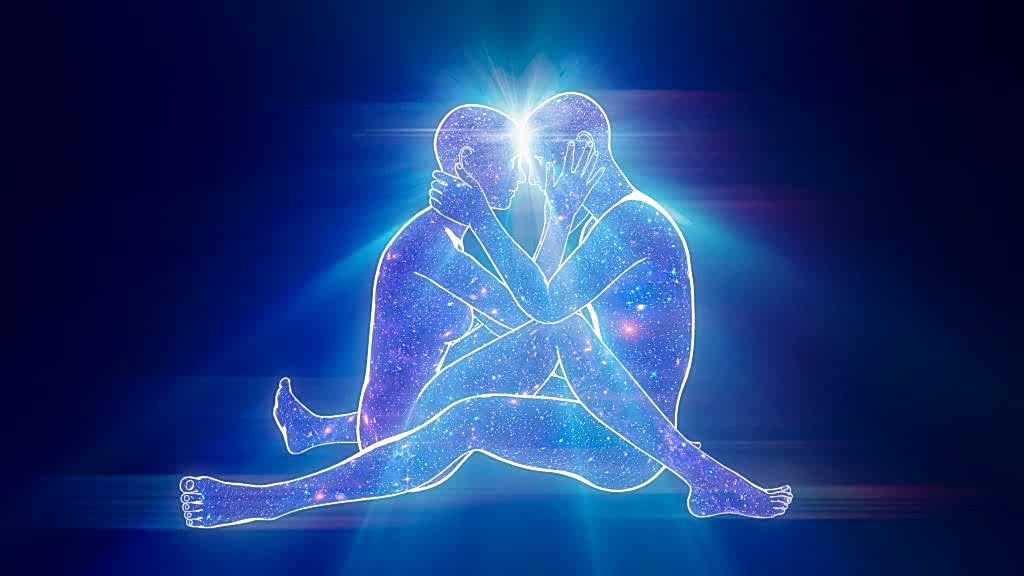
When we make love in this way, not only will our experiences in the bedroom become sacred and sublime, but our whole life experience will be bathed in beauty and the light of awareness
The Erotic Revolution
Though intimacy based on pure eros and amorous erotic continence is an ancient knowledge and practice, it has been a well-kept secret. Because it requires commitment and practice to achieve mastery in this art of love, it is not for those who look for a quick and easy pleasure.
Introducing this apparently new approach to pleasure, love and intimacy could become a genuine revolution in how we live our lives, not only in romantic relationships, but in the overall quality of the experience of life. Erotic Amorous continence invites a slowing down and a deepening, fully savouring what each moment has to offer.
Amorous erotic continence allows us to tap into our incredible potential and gives a renewed appetite for life. It transforms the way we interact with each other, and greatly increases happiness and fulfilment.
Fear, loneliness, depression, feelings of separation, frustration, and anxiety all lie at the root of many of the problems in the modern world. Sex seems to be only a momentary relief from or even an amplifier of these problems. The erotic experience on the other hand, becomes an antidote to and the beginning of a solution to all of the above.
As we transform our relationship with our creative potential, the immense force we hold within, our entire life transforms for the better. We can contribute to the world with more love, kindness, creativity, new perspectives, happiness, optimism and joy. When we make love in this way, not only will our experiences in the bedroom become sacred and sublime, but our whole life experience will be bathed in beauty and the light of awareness.
The way we are in our intimate relationships is reflected in the way we are intimate with life, and with every moment of our existence. When the bedroom is a place of sacred eroticism, life becomes heaven on earth.

Final thoughts
The practice of amorous erotic continence is central to a Tantric practice, both as an immense energetic support for all our spiritual achievements, a refinement of our entire being and as an expression of a more conscious way of approaching intimacy and sensual experiences.
A Tantric practice integrates all aspects of life in a holistic approach that makes every moment valuable from the perspective of spiritual awakening. We aim to embrace everything in the light of awareness, making sacred that which before was considered profane.
Instead of seeing sensuality and erotic desires as an obstacle to spirituality, with the deep understanding of eros and the practises of erotic amorous continence, they are transfigured as a manifestation of life force, and are carefully directed towards the manifestation of a sacred eroticism.
A Tantric saying goes, “The way a man is in the bedroom is the way he lives his life”. This is also valid for a woman. The way we are in our intimate relationships is reflected in the way we are intimate with life, and with every moment of our existence. When the bedroom is a place of sacred eroticism, life becomes heaven on earth.
What is Resonance?
Of all the laws to know the structure of the Universe, nothing could be considered so essential as the discovery that the structure of the universe is based on vibration.
This is a truth shared by both ancient spiritual systems as well as modern science.
While physical matter may appear to be solid, the atoms that make up matter are not just made of smaller solid particles, but rather of dense clouds of elementary particles made of vibrating energy fields. Energy can be understood in terms of vibration, a movement or oscillation from one point to another, and the speed of that oscillation is its frequency – the faster the oscillation, the higher the frequency. In addition, the amplitude of a vibration is the size or distance of that specific oscillation, representing the amount of energy it contains.
This understanding of vibration as being the essence of creation enables things to be defined according to their frequency or rate of vibration. The different colours of the visible light spectrum, for example, are simply different frequencies of electromagnetic energies – the colour we call red has a frequency of about 400 terahertz (trillion cycles per second), the slowest in the colour spectrum, while violet at the other end of the spectrum has a frequency of around 700 THz. Physical bodies, mechanical processes and all energies on the electromagnetic spectrum, that make up visible light, sound waves, radio waves, etc can be defined in terms of frequency.
We find a similar notion in ancient spiritual systems such as Tantra, which sees the entire creation as an unfolding of vibratory energies. These vibrations manifest at various levels of frequency and complexity, starting from a primordial, unique and infinitely fast vibration specific to the subtle world of the spirit, and extending down to the slowest vibrations which characterise all the phenomena and matter in the physical world. In the Kashmir Shaivism tradition, the primordial vibration is described with the Sanskrit word spanda. Spanda is the original, primordial, subtle vibration that is the creative impulse for the unfolding of the universe.
Between the two extremes of creation, the infinite, primordial vibration and physical matter, the entire creation is structured in a hierarchical way, according to frequency of vibration. As creation unfolds, vibrational energies interact with other vibrational energies, forming more and more complex systems of vibration – objects, processes, phenomena and beings, all of which can be defined by their specific frequency.
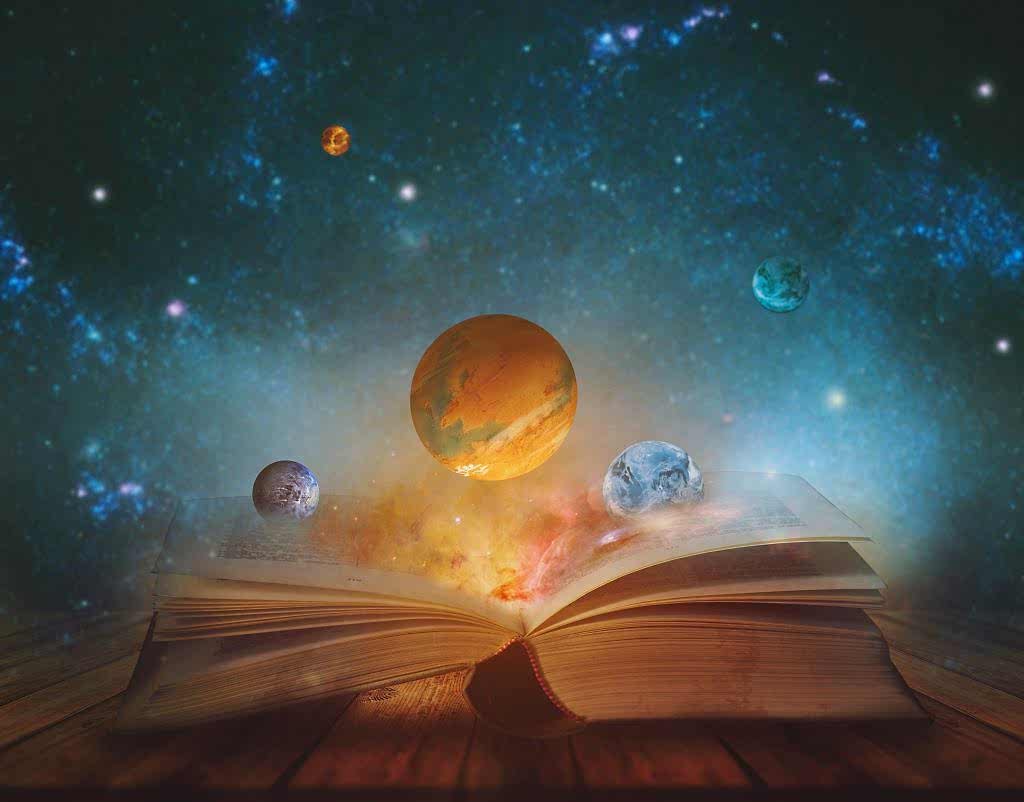
Resonance defines the way systems of vibration interact with each other. When the predominant or natural frequency of two systems are equal to each other or are similar enough, the two systems enter into consonance or syntony and a transfer of energy takes place between them
This unique vision provides us with a perfectly objective way to evaluate each and every element within creation, and to understand how each and every element is connected and related to each other. The nature of the interaction of different vibratory systems can be understood by the phenomenon of resonance. To put it simply, resonance defines the way systems of vibration interact with each other. When the predominant or natural frequency of two systems are equal to each other or are similar enough, the two systems enter into consonance or syntony and a transfer of energy takes place between them. In this phenomena, the amplitude of the vibration in the receiving system is increased.
In the physical world many examples of the resonance phenomena can be found, such as mechanical resonance, acoustic resonance, and electrical resonance. A classic example often used to help understand the phenomenon of resonance is the way a radio functions. In this example the two resonating systems interacting with each other are the broadcasting antenna of the radio station and the radio receiver. The electromagnetic waves from the broadcasting antenna are constantly being transmitted. When the radio is tuned to the frequency of vibration specific to the waves emitted by the radio station, the phenomenon of resonance will appear between the two systems. When this happens, the radio waves are converted to acoustic waves by the radio, and the radio station is then transmitted through the speakers. If we turn the tuning dial, other radio stations can be heard, because the internal structure of the device has been modified by the tuner, to correspond to the new radio station being listened to. In this case, the system emitting the vibration is called the exciter system, and the system receiving the vibration is called the resonating system – because it is the system that attunes through resonance. The phenomenon of syntony appears when the vibratory frequencies of the two systems – the exciter and the resonating system – are similar or identical. Now we can say that resonance has been established between the two systems.

Resonance and Yoga
When the resonance phenomenon is extrapolated to the field of metaphysics, it becomes known as the law of occult resonance. It is occult because certain aspects of this law are mysterious and remain hidden from the common understanding of the phenomenon. Notably, the Tantric vision extends this understanding of resonance to include the subtle dimensions of reality, so that literally everything can be understood of in terms of vibration, not only physical matter, but all subtle phenomena such as emotion or thought.
This law provides us with a unique way to understand how the practices and techniques of yoga work, and what kind of effects a specific technique will produce within the being of the practitioner. The widely known practice of asana-s, or bodily postures, for example, is not just a set of techniques for improving the strength and flexibility of the physical body. From the perspective of the law of occult resonance, the asana-s are methods for consciously tuning into specific resonances that exist in the universe, triggering a vibratory phenomenon that generates precise and known effects. These effects can be perceived in multiple ways, as an energetic phenomenon, an emotion, a feeling, an intuition, an understanding or even a specific state of consciousness.
When we begin to feel a state of love, for example, in that moment a process of resonance is triggered with the endless universal energies of love. The experience that triggered that state of love actually tunes us into the universal source of love and, through resonance, that energy is transferred into our being, amplifying that state within us. All our human experiences can be understood in the same way – even complex processes such as the experience of a sublime and beautiful state of consciousness, or the process of learning and acquiring knowledge and wisdom, can be understood as processes of resonance.

To understand this phenomenon further, the analogy of the functioning of a radio is again useful, as in its description of the way two vibrating systems interact with each other, a third component is included, which is of utmost importance, and that is the tuning mechanism. In the radio, the tuning mechanism is the dial that is adjusted to change the receiving frequency, while in the human being the tuning mechanism is the mind. Not only do we use our body in yoga practice, but even more importantly we use our mind, as it is the mind that controls the process of selecting and tuning into the chosen frequency. This has an important consequence – that all genuine practices of yoga must involve the mind – we need to be aware of exactly where and how we focus the mind so that we can tune into the desired frequency. This could in fact be the way in which we can make the distinction between normal life and spiritual practice. In normal life we are mostly unaware of the processes of resonance that we trigger through our thoughts, words and actions, and we are therefore at the mercy of our habits, reactions, education, and learned and conditioned behaviour, unaware as to the causes of the nature of our daily experiences. In spiritual practice, however, the aim is to be highly aware and to consciously chose the resonances that we want to experience and bring into our life; we are also much more aware of the consequences of certain words, thoughts and actions, which are known clearly to be simply a result of the law of occult resonance. This law also helps us to understand, quite literally, any form of spiritual practice or knowledge. When we interpret something from the perspective of the law of occult resonance, we can discover the deeper, esoteric meaning – a meaning that is significant for our own personal development and spiritual transformation. For example, considering the famous adage, ‘You are what you think’ from the perspective of this law, we can see how significant thoughts are in controlling our resonances – our thoughts shape our own personal reality by continuously creating processes of resonance, which then attract and amplify those energies into our being. This is true whether this is a conscious or unconscious process. With spiritual practice we can train ourselves to make this process more and more conscious, and in this way to have a stronger influence over the nature of our daily experiences and the overall direction of our life.
The Esoteric Significance of Resonance
Going even deeper into the esoteric nature of the law of occult resonance, we encounter another significant spiritual law, known as the law of correspondence.
The principle of energy or vibration and the law of occult resonance provides a deeper understanding of the essential structure of creation and the nature of all the ‘parts’ of creation. The law of correspondence completes this vision by recognising a special relationship between the ‘parts’ and the ‘whole’ of creation. This relationship sees the part as containing the whole through complete reflection, and the whole containing the part – the whole in the part and the part in the whole. As stated in the Hermetic text, the Emerald Tablet, “As above, so below; as below, so above, thus creating the miracle of the whole.”
Known also in modern science as the concept of the holographic universe, this principle embodies the truth that there is always a correspondence between the structure and phenomena of the various planes of existence, and of the underlying unity of creation.This law is of utmost importance in understanding the relationship between the individual, known as the microcosm in Tantra, and the universe, called the macrocosm. A correspondence exists between the individual being and the universe, such that by knowing ourselves we come to know the universe. As stated in the Tantric text, Vishvasara Tantra, “What is here is elsewhere. What is not here is nowhere”, emphasising again the perfect correspondence between the individual and the universal – whatever we find in the microcosm of our own being can also be found in the macrocosm of the universe. Thus, the exploration of the microcosm, or the individual being at all levels, will ultimately lead to the revelation of the essential nature of creation. Thus, we can see how these laws support the ultimate spiritual goal of yoga – true self-knowledge. By knowing ourselves deeply, we come closer to the ultimate revelation of the essence of our own being, and of creation itself.

Conclusion
Understanding the law of occult resonance and the law of correspondence completely transforms the way we approach life, and particularly a spiritual practice, as it provides us with a much more objective way to evaluate our actions. Normally, our perspective upon reality, and therefore the guiding force in how we navigate our way through life, is conditioned and limited by our previous experiences, by our specific education and by our cultural and social conditioning, so that we approach reality in a very subjective way. The law of occult resonance, however, is a genuinely universal law that allows us to evaluate any process, any action, any knowledge, and any perspective from a universal and impartial level, namely, the knowledge of its vibratory nature and thus its precise position and value within the hierarchical structure of reality.
We can also evaluate any form of spiritual practice such as yoga, breathing techniques, or forms of meditation from this objective reference point, by knowing the precise way in which we need to focus the mind and exactly what resonance effect we aim to generate. In our daily yoga practice, and the way we teach and practise in our ongoing courses within this spiritual school, we aim to use the process of resonance to bring the kind of energies into our being that result in beneficial, balancing, creative, regenerative, healing and elevating effects – energies that will support our spiritual evolution and contribute to our integration into the universal macrocosmic harmony
Frequencies are only patterns to their own surroundings, just like us. As beings we can only experience what our surroundings offer. What matters is how we use that experience. We tune into different channels just like a mixing board, our minds separating current and frequencies. We can auto-tune our mind by adjusting our tone, our thoughts, our actions. We are the living experience of cymatics. We are the experience of living information. We are the experience of our surroundings, and our surroundings are experiencing through ourselves. Once we grasp this as a species there will be a true evolution of being.
Cymatics scientist, David Shiermeyer
Yama and Niyama are referred to in the well-known spiritual text of the Yoga Sutras of Patanjali in which the 8 steps of the Yoga system are listed.
The Yamas and Niyamas constitute the first two steps. The eight steps are listed as such:
- Yama (controlling oneself/restraints)
- Niyama (moral observances/positive duties)
- Asana (bodily postures)
- Pranayama (control of the breath)
- Pratyahara (retraction of the senses from the external world)
- Dharana (mental concentration)
- Dhyana (Deep meditation)
- Samadhi (state of spiritual ecstasy)
It becomes obvious that yoga is more than the bodily postures that it is famous for, as indeed postures (asana) constitute only one of the steps listed in the Yoga Sutras. The path of Yoga – meaning to yoke, to unite – connects the individual to the universal.
This connection leads to an increased sense of wellbeing and wholeness. As well as enjoying your individuality in a new light and understanding, you can enjoy the sense of interconnectedness with other beings and with the source of all being. In yoga we aim to simultaneously enjoy the game of life while at the same time maintaining an awareness of, and an increasing communion with, its sacred source. When followed to perfection the steps of yoga can take us to samadhi, divine ecstasy, and complete self-realisation.
The yamas and niyamas offer guidance on the most beneficial integration of the individual in the macrocosmic whole.
The yamas and niyamas offer guidance on the most beneficial integration of the individual in the macrocosmic whole – both in terms of inner attitudes that should be cultivated, as well as certain outer guidelines for our interactions with the world at large. These in turn create the foundation of our further development and the first steps on our journey to the highest realisations.
Broadly speaking, we can say that Yamas and Niyamas are ethical and moral guidelines that help us build a harmonious life. They can be seen as being at the very foundation of any yoga practice, yet often they are ignored – or at least not recognised as the essential aspects of the yogic practice that they are.
In the following we will briefly present each yama and niyama, though each in turn deserve in-depth study. In our courses the yamas and niyamas are studied in greater detail.
The 5 Yamas or ‘restraints’ focus on our relationship with others and generally the outer world:

Ahimsa (non-violence) – refraining from violence in action, speech and thought – becoming aware of and countering the ego’s tendency to strike out in anger when it feels threatened or under pressure. Learning to react in a different way, our ego relaxes and a new sense of individuality can emerge.
Satya (truthfulness) – the restraint of not lying or deceiving others. Satya implies always being honest with yourself and others. When we are in the habit of being dishonest, we cannot realise the Ultimate Truth. Often the one we lie to the most is ourselves. Any process of genuine transformation can only begin from where and who we are in this moment and we need the courage to be honest with ourselves about what that is.
Asteya (non – stealing) – refraining from taking anything that does not belong to us, including that which arises in our mind. This does not only refer to physical objects but also other achievements. We should be attentive of the desire to take what belongs to someone else and rather take it as an inspiration to become able to have that for ourselves.
Brachmacharya (continence or abstinence) – the restraint in sensual cravings and desires of a sexual nature. We often waste a lot of resources on the unconscious indulgence in the senses, or the wasteful use of our creative sexual power. Traditionally this has led to the indication of sexual abstinence for those serious about their spiritual practice and evolution. In our school we teach the alternative; a way of harnessing the immense creative potential present in our desires, through what is called amorous erotic continence. More about that can be found in the pillar Eros and Amorous Erotic Continence.
Aparigraha – (non-grasping) – means to let go of the exhausting need to grasp everything for ourselves and to avoid accumulating physical objects. It also means letting go of our tendency to grasp tightly to ideas or thoughts that we think define us, and to open ourselves up to new ideas and perspectives.
Allthough the yamas are called restraints we realise that Ahimsa (non-violence) actually means acting, speaking, and thinking based on love and kindness; Asteya (non-stealing) means generosity and the appreciation of the achievements of others; Aparigraha (non-grasping) means detachment and expansion, selflessness; Satya (truthfulness) means the pursuit of the Ultimate Truth, beauty, and goodness; Brachmacharya means harnessing and consciously using all our energies for their highest purpose.
The 5 Niyamas or positive duties refer to our relationship with ourselves, our inner world and the highest reality:
Saucha (purification) – Many mystical paths (those paths in which the practitioner aims to come into a felt connection with the divine) emphasise the need for purification of our entire being. The analogy that is sometimes given is that of the lamp: Deep within us, there is an inner light of joy, goodness, peace, and harmony – the spark of divinity within each of us. However, as we go through life (especially if we aren’t conscious of the need for purification practices) this becomes covered with layers of ‘dust’ until this light is dimmed or even no longer visible to ourselves or others. Yoga’s emphasis on purification practices is to clean the ‘dust’ at the various levels of our being (physical, energetic, emotional, mental). Our courses offer purification techniques for body, mind and emotions.

Santosha (contentment) – actively helps in cultivating a sense of contentment and well-being to counter the ego’s tendency to feel a sense of lack which in turn leads to grasping, accumulation and theft. The state of contentment is cultivated no matter what the external circumstances might be and leads to inner peace and a profound sense of wellbeing.
Tapas (ardent effort) – is related to action, to practice. Through yoga practice, (postures, breathing exercises, meditation, visualisation, nutrition, purification, etc.) we develop ourselves; we strengthen ourselves, and we awaken to new experiences and the lived truth of new perspectives. Tapas comes from the root word Tap – which means ‘to burn’. Tapas means to awaken the inner fire, the inner will power, to apply ourselves with dedication to the practice we have chosen, recognising that the more we put in, the more we get out. Setting a practice, and applying ourselves to this with determination and enthusiasm, burns the present limits so that we can grow and expand beyond them. Through ardent practice we can experience states of consciousness way beyond the ordinary experiences that are within the natural capacities of the human being, but rarely accessed by the majority.
Svadhyaya (Self-study) – Yoga is a Gnostic path, a path of salvation through knowledge that brings a deep understanding yourself and your relationship to the whole. Studying the wisdom of those who have reached spiritual illumination in the form of spiritual texts, (texts which include the essence of wisdom of different authentic spiritual traditions), can help us in our own quest for this knowledge. Then, through the deep and attentive study of ourselves we can discover the universal truths that are contained in these spiritual texts and also expressed by other seekers.
Ishvarapranidhana (devotion, surrender) – means devotion to the sacred, to the divine. It refers to an awakening sense of the sacredness of life; feeling ourselves in relationship with the mystery and magic of existence. It speaks to a desire to find something worthy of devotion.
Someone once said that we all worship something – that might be money, celebrity, success, etc. So, better find something truly nourishing that gives us a healthy perspective of ourselves and our place in the world. Placing ourselves in a relationship of feeling humbleness, great love and surrender towards something greater than us (such as the attitude shown by those who faithfully prostrate or pray to God/the Supreme Absolute/a Godly entity) can induce a state of liberty, of freedom, and of safety, being in the hands of something greater than us.Ishvarapranidhana relates to aspiration; aspiration to be in right relationship to something, and aspiration to become a better person with that understanding and through that surrender.

Final thoughts
It is not by chance that the yamas and niyamas are placed at the very beginning of our spiritual journey. Embodying the wish to be the best human being we can be, and to integrate ourselves into a greater harmony, they express the awakening of our consciousness and our aspiration to discover more of our inner world and potentials.
At first glance they seem simple ideas and are often overlooked. Even advanced yoga practitioners, who either have not been introduced to them or may have only heard about them, may realise that they do not actively think of these principles. They are easy to ignore, but it bears fruit to revisit them again and again, to gain deeper insight. If ignored we will face problems later on our path, lacking the firm foundation to support higher states of consciousness and the experience of divine ecstasy, Samadhi.
In the yoga and tantra courses Yamas and Niyamas are each thoroughly presented and one can go deep into them as a genuine part of the yogic and tantric practice.
